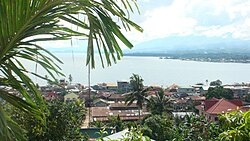Lake Lanao
| Lake Lanao | ||
|---|---|---|
Primary inflows 4 tributaries | | |
| Primary outflows | Agus River | |
| Catchment area | 1,678 km2 (648 sq mi) [1] | |
| Basin countries | Philippines | |
| Max. length | 33 km (21 mi) | |
| Max. width | 20 km (12 mi) | |
| Surface area | 334 km2 (129 sq mi)[2] | |
| Average depth | 60.3 m (198 ft)[2] | |
| Max. depth | 112 m (367 ft)[2] | |
| Water volume | 21.28 km3 (5.11 cu mi) [1] | |
| Shore length1 | 115 km (71 mi) | |
| Surface elevation | 700 m (2,300 ft) [1] | |
| Settlements | ||
| 1 Shore length is not a well-defined measure. | ||
Lake Lanao (

History
In 1965, Lake Lanao was renamed to Lake Sultan Alonto by Republic Act No. 4260,[4] which was later repealed by Republic Act No. 6434 in 1972.[5]
The lake has great
Section 22 of Article XIII of the
In October 2006, a study from the Mindanao State University discovered massive algae contamination in Lake Lanao.[9] Initially, poor sewage and agricultural waste management were seen as the culprits of the contamination. However, the Department of Agriculture and the Bureau of Fisheries and Aquatic Resources stated that soil erosion from indiscriminate logging and extensive land use and farming are the problems that caused the algae contamination.[2]
Physical characteristics
The lake was formed by the
The lake is fed by four rivers, the Ramain, Taraka, Gata, and Masiu. Its only outlet is the Agus River, which flows northwest into Iligan Bay via two channels, one over the Maria Cristina Falls and the other over the Tinago Falls.
Four islands can be found in the lake:
- Balutmaito Island
- Balutmasla Island
- Nusa Island
- Salungan Island
Biodiversity
The lake is (or was) home to 17
However, an investigation in 1992 only managed to locate three of the endemic/near-endemic fish species,
The 18 endemic/near-endemic cyprinid species of Lake Lanao (B. binotatus also occurs, but it is a widespread species):[6]
- Barbodes amarus Herre (pait; dipura)
- Barbodes baoulan Herre ** (baolan)
- Barbodes clemensi Herre (bagangan)
- Barbodes disa Herre ** (Diza)
- Barbodes flavifuscus Herre (tumba)
- Barbodes herrei (Fowler, 1934)
- Barbodes katolo Herre (katolo)
- Barbodes lanaoensis Herre (kundur)
- Barbodes lindog Herre ** (lindog)
- Barbodes manalak Herre ** (manalak)
- Barbodes pachycheilus Herre (Bongkaong)
- Barbodes palaemophagus Herre (bitungu)
- Barbodes palata Herre ** (palata)
- Barbodes resimus Herre * (bagangan sa erungan)
- Barbodes sirang Herre sirang; (Tumaginting)
- Barbodes tras Herre (tras)
- Barbodes truncatulus Herre (bitungu)
- Regan(tumba)
Notes:
* — Biggest native species in Lake Lanao
** — Species of high commercial value
Other native species:[12]
- Ophicephalus striatus(aruan)
- Anguilla celebensis(kasili)
Anguilla celebensis has historically been present in the lake, apparently making its way in from the sea through subterranean waterways inaccessible to other fish.[11][12] However, it has rarely been reported in fisherman surveys since 1990, suggesting that the species is extant but extremely rare.[12]
Introduced species:[12]
- Hypseleotris agilis(katolong)
- Glossogobius giuris(kadurog)
- Glossogobius celebius (kadurog)
- Oreochromis mossambicus(tilapia)
- Oreochromis niloticus(tliapia)
- Trichogaster pectoralis(gourami)
- Anabas testudineus (popoyo)
- Chanos chanos(bangus)
- Clarias macrocephalus(katipa)
- Clarias batrachus(katipa)
In a 2008 fish landing survey, Hypseleotris agilis (sleeper goby) comprised 66.6% of the fish caught by weight. The gobies, including G. giuris and G. celebius, were found to prey on small fish, and as such, are considered the primary cause of the endemic species' decline.[12]
In culture
Lake Lanao is home to many important myths and legends of the
References
- ^ a b c d e f g h i j "About Lake Lanao | Lake Lanao". lakelanao.com. Archived from the original on August 19, 2011.
- ^ a b c d e f g h i j k Lake Lanao. Archived from the original on January 3, 2009. Retrieved August 2, 2008 – via ranaw.com.
- ^ a b Limos, Mario Alvaro (August 31, 2021). "The Tragedy of Lake Lanao, Southeast Asia's Only Ancient Lake". Esquire Philippines. Retrieved April 2, 2022.
- ^ Republic Act No. 4260 – via Supreme Court E-Library.
- ^ Republic Act No. 6434 – via Supreme Court E-Library.
- ^ ISBN 9718511539. Retrieved July 7, 2023.
- ^ Proclamation No. 871, s. 1992. Archived from the original on October 26, 2017. Retrieved June 19, 2021 – via Official Gazette of the Republic of the Philippines.
- ^ Yahya, Masiding Noor (July 14, 2019). "Maranaos Seek Amendment of Bangsamoro Law". Manila Times.
- ^ "Contaminated Lake Lanao in Danger". MindaNews. October 14, 2006. Retrieved December 30, 2021.
- ^ S2CID 13788351.
- ^ doi:10.1086/280475.
- ^ hdl:1957/21823. Retrieved July 6, 2023.
- ^ a b Nilsson, Greta (2005). "It's Too Late – Fish Extinctions". Endangered Species Handbook (PDF). Washington DC: Animal Welfare Institute.
- ^ "European Bison Recovering, 31 Species Declared Extinct – IUCN Red List". IUCN. December 10, 2020. Retrieved December 10, 2020.
- ISBN 0-412-09651-X.
- ISBN 0-306-46092-0.
- ^ Mendoza, Jose Christopher E; Naruse, Tohru (2010). "A New Species of Riverine Crab of the Genus Sundathelphusa Bott, 1969 (Crustacea: Brachyura: Gecarcinucidae) from Northeastern Luzon, Philippines" (PDF). Philippine Journal of Science. 139 (1): 61–70.
- ^ "How the Angels Built Lake Lanao". seasite.niu.edu. Archived from the original on February 20, 2020. Retrieved March 23, 2007.
- ^ "Legend of Lake Lanao (Maranaw Legend)". September 14, 2014 – via SlideShare.
External links
- Lydia P. Oliva (1985). "Economics of Tilapia Cage Culture in Mindanao, Philippines". In Ian R. Smith; Enriqueta B. Torres; Elvira O. Tan (eds.). Philippine Tilapia Economics (PDF). Philippine Council for Agriculture and Resources Research and Development. pp. 83–106. ISSN 0115-4435.
